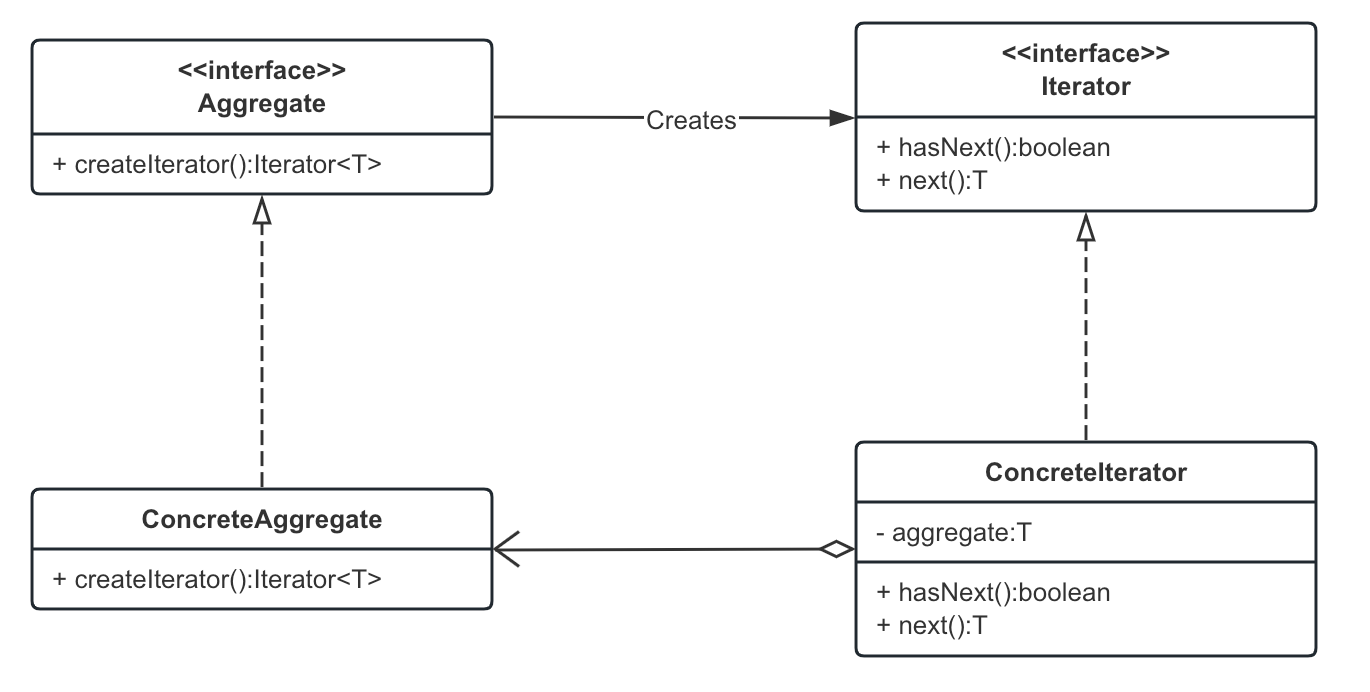重学设计模式-Iterator(迭代器模式)
发布时间:2023年12月21日
Iterator迭代器模式
介绍:
- 迭代器模式是一种
- List item
行为型设计模式,它允许你在不暴露集合底层表示(并不知道集合底层使用何种方式对数据尽心存储)的情况下遍历集合中的元素。
- 这种模式提供了一种方法,可以顺序访问一个聚合对象中的各个元素,而又不需要暴露该对象的内部表示。
- 迭代器模式通常包括两个角色:迭代器和聚合对象。
- 迭代器(Iterator,读取元素)
- 负责定义访问和遍历元素的接口
- 实现了该接口的类,拥有访问聚合对象中元素的能力
- 聚合对象(Aggregate,存储元素)
- 负责定义创建相应迭代器对象的接口,该接口返回一个适当的迭代器实例
- 实现了该接口的类将成为一个可以保存多个元素的集合,就像数组一样
- 迭代器(Iterator,读取元素)
以下是一个简单的迭代器实例,演示了如何使用迭代器模式遍历一个集合:
1、抽象实例
创建迭代器接口:
/**
* 迭代器接口
*
* @author supanpan
* @date 2023/12/21
*/
public interface Iterator<T>{
/**
* 判断是否存在下一个元素
* @return: 循环终止条件
* true:集合中存在下一个元素
* false:集合中不存在下一个元素
*/
boolean hasNext();
/**
* 获取下一个元素,并且将迭代器指针位置移动到下一个元素
*/
T next();
}
实现迭代器接口,具体迭代器实现:
/**
* 具体迭代器实现
*
* @author supanpan
* @date 2023/12/21
*/
public class ConcreteIterator<T> implements Iterator<T> {
private List<T> list;// 存放元素的列表
private int position;// 遍历元素的下标
/**
* 初始化迭代器
*
*/
public ConcreteIterator(List<T> list) {
this.list = list;
this.position = 0;
}
/**
* 判断是否到集合的末尾
*
*/
@Override
public boolean hasNext() {
return position < list.size();
}
/**
* 遍历(迭代)集合取出相应元素
*
*/
@Override
public T next() {
if (!hasNext()){
throw new NoSuchElementException("没有元素了......");
}
T item = list.get(position);
position++;
return item;
}
}
创建聚合对象:
/**
* 聚合对象
*
* @author supanpan
* @date 2023/12/21
*/
public interface Aggregate<T> {
/**
* 生成一个用于遍历集合的迭代器
*
*/
Iterator<T> createIterator();
}
实现聚合对象接口,创建具体聚合对象:
/**
* 具体聚合对象
*
* @author supanpan
* @date 2023/12/21
*/
public class ConcreteAggregate<T> implements Aggregate<T>{
private List<T> items;
public ConcreteAggregate() {
this.items = new ArrayList<>();
}
/**
* 向集合中添加元素
* @param item 待添加元素
*/
public void addItem(T item){
items.add(item);
}
/**
* 创建迭代器对象
*
* @return 具体的迭代器
*/
@Override
public Iterator<T> createIterator() {
// items.sort(null);// 在创建迭代器之前对集合中的元素进行排序操作
return new ConcreteIterator<>(items);// 将聚合对象中的集合传递给具体迭代器对象,以供访问
}
}
测试Main:
public class Main {
public static void main(String[] args) {
// 创建聚合对象
ConcreteAggregate<String> aggregate = new ConcreteAggregate<>();
// 向聚合对象中添加元素
aggregate.addItem("Item 1");
aggregate.addItem("Item 3");
aggregate.addItem("Item 2");
aggregate.addItem("Item 4");
// 获取迭代器对象
Iterator<String> iterator = aggregate.createIterator();
// 使用迭代器模式进行遍历
while (iterator.hasNext()){
// 获取迭代器中的元素
String item = iterator.next();
System.out.println(item);
}
}
}
2、书架实例
创建聚合对象,用于将具体实现类中的集合通过迭代器进行返回
public interface Aggregate<T> {
Iterator<T> iterator();
}
创建迭代器对象,用于访问聚合对象中的数组数据
public interface Iterator<T> {
boolean hasNext();
T next();
}
创建Book对象,Book对象用于获取书籍的名称
public class Book {
private String name;// 书籍名称
public Book(String name) {
this.name = name;
}
public String getName() {
return name;
}
}
创建BookShelf对象,这个对象实现了Aggregate接口,拥有聚合元素的能力
public class BookShelf implements Aggregate{
private ArrayList<Book> books;// 对比抽象实例中的数组,这里改成了存放书籍的列表
/**
* 初始化集合对象
*
* @param initialSize 集合大小
*/
public BookShelf(int initialSize){
this.books = new ArrayList<>(initialSize);
}
public Book getBookAt(int index) {
return (Book) books.get(index);
}
public void appendBook(Book book) {
books.add(book);
}
public int getLength() {
return books.size();
}
/**
* 将书籍数组返回给具体迭代器实现类,提供访问书籍数组的能力
*
*/
public Iterator iterator() {
return new BookShelfIterator(this);
}
}
创建BookShelfIterator对象,这个对象实现了Iterator接口,拥有访问聚合对象中的数据能力
public class BookShelfIterator implements Iterator{
private BookShelf bookShelf;
private int index;
/**
* 初始化迭代器
* @param bookShelf 聚合对象集合数据
*/
public BookShelfIterator(BookShelf bookShelf) {
this.bookShelf = bookShelf;
this.index = 0;
}
@Override
public boolean hasNext() {
return index < bookShelf.getLength();
}
@Override
public Object next() {
Book item = bookShelf.getBookAt(index);
index++;
return item;
}
}
测试类:
public class Main {
public static void main(String[] args) {
BookShelf bookShelf = new BookShelf(4);
bookShelf.appendBook(new Book("时间简史"));
bookShelf.appendBook(new Book("活着"));
bookShelf.appendBook(new Book("百年孤独"));
bookShelf.appendBook(new Book("1984"));
bookShelf.appendBook(new Book("三体"));
bookShelf.appendBook(new Book("围城"));
bookShelf.appendBook(new Book("小王子"));
bookShelf.appendBook(new Book("云边的小卖部"));
Iterator it = bookShelf.iterator();
while (it.hasNext()) {
Book book = (Book)it.next();
System.out.println(book.getName());
}
}
}
3、Iterator总结
通过以上两个实例,在每个实例中,都出现了相对重要的接口和实现类,这四个关键角色,分别是Iterator(迭代器)、ConcreteIterator(具体的迭代器)、Aggregate(聚合对象)和ConcreteAggregate(具体的聚合对象)。
- Iterator(迭代器):
- Iterator是一个接口,它定义了在集合对象上进行迭代的方法
hasNext()用于检查是否还有下一个元素next()用于获取下一个元素。
- ConcreteIterator(具体的迭代器):
- ConcreteIterator是Iterator接口的具体实现,它持有对应的集合对象,并且在内部实现了迭代逻辑。
- 具体的迭代器类通常会包含一个指向当前元素的游标,并且实现了Iterator接口中定义的方法。
- Aggregate(聚合对象):
- Aggregate是一个接口,它定义了创建迭代器对象的方法,例如
createIterator() - 聚合对象是包含一组元素的对象,它通常会提供一种方式来获取迭代器对象,使得外部客户端可以通过迭代器遍历聚合对象中的元素。
- ConcreteAggregate(具体的聚合对象):
- ConcreteAggregate是Aggregate接口的具体实现,它实现了创建迭代器对象的方法,并且通常会包含一个内部集合来存储元素。
- 具体的聚合对象类会将迭代器对象的创建委托给具体的迭代器类。
下面是Iterator实现的类图:

文章来源:https://blog.csdn.net/weixin_45688141/article/details/135127309
本文来自互联网用户投稿,该文观点仅代表作者本人,不代表本站立场。本站仅提供信息存储空间服务,不拥有所有权,不承担相关法律责任。 如若内容造成侵权/违法违规/事实不符,请联系我的编程经验分享网邮箱:chenni525@qq.com进行投诉反馈,一经查实,立即删除!
本文来自互联网用户投稿,该文观点仅代表作者本人,不代表本站立场。本站仅提供信息存储空间服务,不拥有所有权,不承担相关法律责任。 如若内容造成侵权/违法违规/事实不符,请联系我的编程经验分享网邮箱:chenni525@qq.com进行投诉反馈,一经查实,立即删除!